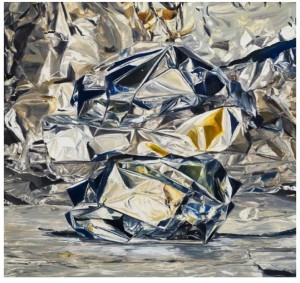William Daniels at Luhring Augustine
Yet each work becomes a monument on the wall it occupies—a monumental piece of tiny intricacy, perhaps even a commentary on the blankness of the wall itself. Each piece is a wonder of astounding color and shape relationships, revealed through careful and extensive examination. Every square inch is afforded the same attention as the next. This endless array alone makes the work appealing. The colors seem to emerge from another, unknown dimension, expressing the fact that they have been observed, not directly but through reflection. They are richly otherworldly. This spectral quality is enhanced by a kind of “missing twin” effect. Knowing that the paintings are based on maquettes, the viewer does double duty, first in apprehending the painstaking painted facsimile, then in trying to imagine the absent model.
Works of the Cubists, such as Picasso’s “Demoiselles D’Avignon” or Duchamp’s “Nude Descending a Staircase” come to mind and all the paintings invoke Cubist qualities. But the paradox is that Daniels is in fact painting Cubism directly. That is, the multiple viewpoints beloved of cubism are achieved through the planes and folds of the maquette and its shiny reflective surface, while the artist paints this “Cubist” array from a Renaissance single-point perspective. Whatever conceptual trompe l’oeil is thus deployed, it is certain that the staggering depth and intricacy of the painted trompe l’oeil leads the viewer down new paths of color and shape.
Greg Lofthouse






